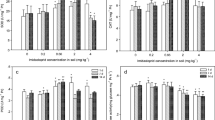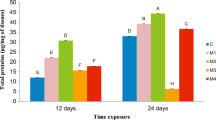Abstract
The aim of this study was to investigate the biochemical responses in three earthworm species, Eudrilus eugeniae, Perionyx ceylanensis and Perionyx excavatus induced by exposure to pesticide (carbaryl) and metal (lead) in soil. Earthworms were exposed to increasing concentrations of carbaryl (12, 25 and 50 mg kg −1) and Pb (75, 150 and 300 mg kg −1) in the soil for different periods of time and the biochemical changes were determined. The protein content was slightly increased in E. eugeniae, P. ceylanensis when exposed to the lower concentration of Pb (75 mg kg−1). But decreased protein content was observed in P. excavatus at the higher concentration of carbaryl (50 mg kg−1), and with exposure to 300 mg kg−1 Pb in P. ceylanensis. The changes in the levels of antioxidant enzymes glutathione-S-transferase (GST), glutathione peroxidase (GPx), reduced glutathione (GSH), superoxide dismutase (SOD) and catalase (CAT) were used as functional biomarkers to determine the effect of pesticides and metals on earthworms. Among these, GST exhibited more sensitive response to both carbaryl and Pb as compared to the control. Other antioxidant enzymes showed little variation at the time of exposure. The results of our study suggested that both carbaryl and Pb induced the production of Reactive oxygen species (ROS) by causing oxidative damage to cells. Due to an adaptive response of earthworms in contaminated soils, they could be used as significant biomarkers to asses the toxicity in the environment of the soil ecosystem. This is the first report on the comparative study of antioxidant enzyme activities in three earthworm species under normal and stress induced conditions.


Similar content being viewed by others
References
Anderson ME (1996) Glutathione. In: Neville AP, Frank JK (eds) Free radicals: a practical approach. Oxford University Press, New York, pp. 213–225
Bernard F, Brulle F, Dumez S, Lemiere S, Platel A, Nesslany F, Cuny D, Deram A, Vandenbulcke F (2014) Antioxidant responses of annelids, Brassicaceae and Fabaceae to pollutants: a review. Ecotoxicol Environ Saf. doi:10.1016/j.ecoenv.2014.04.024
Caselli F, Gastaldi L, Gambi N, Fabbri E (2006) In vitro characterization of cholinesterases in the earthworm Eisenia andrei. Comp Biochem Physiol C: Toxicol Pharmacol 143:416–421
Claiborne A (1985) Catalase activity. In: Greenwald RA (ed) CRC handbook of methods for oxygen radical research. CRC, Boca Raton, pp. 283–284
Clair DKS, Chow CK (1996) Glutathione peroxidase activity and steady state level of mRNA. In: Neville AP, Frank JK (eds) Free radicals: a practical approach. Oxford University Press, New York, pp. 227–238
Du L, Li G, Liu M, Li Y, Yin S, Zhao J (2015) Biomarker responses in earthworms (Eisenia fetida) to soils contaminated with di-n-butyl phthalates. Environ Sci Pollut Res 22:4660–4669
Feng L, Zhang L, Zhang Y, Zhang P, Jiang H (2015) Inhibition and recovery of biomarkers of earthworm Eisenia fetida after exposure to thiacloprid. Environ Sci Pollut Res. doi:10.1007/s11356-015-4122-6
Gambi N, Pasteris A, Fabbri E (2007) Acetyl choline esterase activity in the earthworm Eisenia andrei at different conditions of carbaryl exposure. Comp Biochem Physiol C: Toxicol Pharmacol 145:678–685
Giannopolitis CN, Ries SK (1977) Superoxide dismutases: I. Occurrence in higher plants. Plant Physiol 59:309–314
Gomez-Eyles JL, Svendsen C, Lister L, Martin H, Hodson ME, Spurgeon DJ (2009) Measuring and modelling mixture toxicity of imidacloprid and thiacloprid on Caenorhabditis elegans and Eisenia fetida. Ecotoxicol Environ Saf 72:71–79
Habig WH, Pabst MJ, Jakoby WB (1974) Glutathione-S-transferase: the first enzymatic step in mercapturic acid formation. J Biol Chem 249:7130–7139
Halliwell B, Gutteridge JMC (1999) Free radicals in biology and medicine, 3rd edn. Oxford University Press, New York, pp. 617–783
Kammenga JE, Dallinger R, Donker MH, Köhler HR, Simonsen V, Triebskorn R, Weeks JM (2000) Biomarkers in terrestrial invertebrates for ecotoxicological soil risk assessment. Rev Environ Contam Toxicol 164:93–147
Kauschke E, Mohrig W, Cooper EL (2007) Coelomic fluid proteins as basic components of innate immunity in earthworms. Eur J Soil Biol 43:110–115
Kobayashi H, Ohta N, Umeda M (2004) Biology of lysenin, a protein in the coelomic fluid of the earthworm Eisenia foetida. Int Rev Cytol 236:45–99
Kohlerova P, Beschin A, Silerova M, De Baetselier P, Bilej M (2004) Effect of experimental microbial challenge on the expression of defense molecules in Eisenia foetida earthworm. Dev Comp Immunol 28:701–711
Langdon CJ, Hodson ME, Arnold RE, Black S (2005) Survival, Pb uptake and behaviour of three species of earthworm in Pb treated soils determined using an OECD-style toxicity test and a soil avoidance test. Environ Pollut 138:368–375
Lima MP, Cardoso DN, Soares AM, Loureiro S (2015) Carbaryl toxicity prediction to soil organisms under high and low temperature regimes. Ecotoxicol Environ Saf 114:263–272. doi:10.1016/j.ecoenv.2014.04.004
Liu S, Zhou Q, Wang Y (2011) Ecotoxicological responses of the earthworm Eisenia fetida exposed to soil contaminated with HHCB. Chemosphere 83:1080–1086
Lowry OH, Rosebrough NJ, Farr AL, Randall RJ (1951) Measurement of protein with the folin phenol reagent. J Biol Chem 193:265–275
Luo W, Verweij RA, Van Gestel CA (2014) Determining the bioavailability and toxicity of lead contamination to earthworms requires using a combination of physicochemical and biological methods. Environ Pollut 185:1–9
Maity S, Roy S, Chaudhury S, Bhattacharya S (2008) Antioxidant responses of the earthworm Lampito mauritii exposed to Pb and Zn contaminated soil. Environ Pollut 151:1–7
Maity S, Roy S, Bhattacharya S, Chaudry S (2010) Antioxidant responses of the earthworm Lampito mauritti exposed to lead and zinc contaminated soil. Soil Biol Biochem 25:265–279
OECD (2002) OECD Guideline for the testing of chemicals 308, Aerobic and Anaerobic Transformation in Aquatic Sediment Systems http://www.oecd-ilibrary.org/environment/oecd-guidelines-for-the-testing-of-chemicals-section-3-degradation-and-accumulation_2074577x
Paul JAJ, Karmegam N, Daniel T (2011) Municipal solid waste (MSW) vermicomposting with an epigeic earthworm, Perionyx ceylanensis Mich. Bioresour Technol 102:6769–6773
Ribera D, Narbonne JF, Arnaud C, Saint-Denis M (2001) Biochemical responses of the earthworm Eisenia fetida andrei exposed to contaminated artifcial soil, effects of carbaryl. Soil Biol Biochem 33:1123–1130
Saint-Denis M, Narbonne JF, Arnaud C, Ribera D (2001) Biochemical responses of the earthworm Eisenia fetida andrei exposed to contaminated artificial soil: effects of lead acetate. Soil Biol Biochem 33:395–404
Sandalio LM, Dalurzo HC, Gómez M, Romero-Puertas MC, del Rio LA (2001) Cadmium induces changes in the growth and oxidative metabolism of pea plants. J Exp Bot 52:2115–2126
Saxena PN, Gupta SK, Murthy RC (2014) Comparative toxicity of carbaryl, carbofuran, cypermethrin and fenvalerate in Metaphire posthuma and Eisenia fetida-a possible mechanism. Ecotoxicol Environ Saf 100:218–225
Song Y, Zhu LS, Wang J, Wang JH, Liu W, Xie H (2009) DNA damage and effects on antioxidative enzymes in earthworm (Eisenia fetida) induced by atrazine. Soil Biol Biochem 41:905–909
Spurgeon DJ, Ricketts H, Svendsen C, Morgan AJ, Kille P (2005) Hierarchical responses of soil invertebrates (earthworms) to toxic metal stress. Environ Sci Technol 39:5327–5334
Tai TY, Lin YS, He J (2008) Effect of Cu, Pb single and combined pollution on total soluble protein content and SOD activity of the Eisenia foetida earthworm in soils. J Agro-Environ Sci 27:1985–1990
Vandana S, Keshav S (2015) Toxic effect of herbicide 2, 4-D on the earthworm Eutyphoeus waltoni Michaelsen. Environ Process 2:251–260
Wang X, Chang L, Sun Z, Zhang Y, Yao L (2010) Analysis of earthworm Eisenia fetida proteomes during cadmium exposure: an ecotoxicoproteomics approach. Proteomics 10:4476–4490. doi:10.1002/pmic.201000209
Yang X, Song Y, Ackland ML, Liu Y, Cao X (2012) Biochemical responses of earthworm Eisenia fetida exposed to cadmium-contaminated soil with long duration. Bull Environ Contam Toxicol 89:1148–1153. doi:10.1007/s00128-012-0837-y
Zaltauskaite J, Sodiene I (2014) Effects of cadmium and lead on the life-cycle parameters of juvenile earthworm Eisenia fetida. Ecotoxicol Environ Saf 103:9–16
Zhang J, Yu J, Ouyang Y, Xu H (2013) Responses of earthworm to aluminum toxicity in latosol. Environ Sci Pollut Res 20:1135–1141
Zhang W, Chen L, Liu K, Chen L, Lin K, Guo J, Liu L, Cui C, Yan Z (2014) Lead accumulations and toxic effects in earthworms (Eisenia fetida) in the presence of decabromodiphenyl ether. Environ Sci Pollut Res 21:3484–3490
Zheng K, Liu Z, Li Y, Cui Y, Li M (2013) Toxicological responses of earthworm (Eisenia fetida) exposed to metal contaminated soils. Environ Sci Pollut Res 20:8382–8390
Zhou X, Zhang QR, Liang JD (2006) Toxic effects of acetochlor and methamidophos on earthworm Eisenia fetida in phaiozem, northeast China. J Environ Sci 18:741–745
Acknowledgments
Authors sincerely acknowledge Prof. (Mrs.) Thilagavathy Daniel, Department of Biology, Gandhigram Rural Institute, Gandhigram for her keen interest in the study and for valuable suggestions.
Author information
Authors and Affiliations
Corresponding author
Ethics declarations
Conflict of Interest
The authors declare that they have no conflict of interest.
Rights and permissions
About this article
Cite this article
Jeyanthi, V., Paul, J.A.J., Selvi, B.K. et al. Comparative Study of Biochemical Responses in Three Species of Earthworms Exposed to Pesticide and Metal Contaminated Soil. Environ. Process. 3, 167–178 (2016). https://doi.org/10.1007/s40710-016-0131-9
Received:
Accepted:
Published:
Issue Date:
DOI: https://doi.org/10.1007/s40710-016-0131-9




